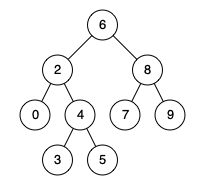Given a binary search tree (BST), find the lowest common ancestor (LCA) of two given nodes in the BST.
According to the definition of LCA on Wikipedia: “The lowest common ancestor is defined between two nodes p and q as the lowest node in T that has both p and q as descendants (where we allow a node to be a descendant of itself).”
Given binary search tree: root = [6,2,8,0,4,7,9,null,null,3,5]

Example 1:
Input: root = [6,2,8,0,4,7,9,null,null,3,5], p = 2, q = 8 Output: 6 Explanation: The LCA of nodes2and8is6.
Example 2:
Input: root = [6,2,8,0,4,7,9,null,null,3,5], p = 2, q = 4 Output: 2 Explanation: The LCA of nodes2and4is2, since a node can be a descendant of itself according to the LCA definition.
Note:
- All of the nodes' values will be unique.
- p and q are different and both values will exist in the BST.
M1: recursive
从root开始找,如果p, q都在左,继续往左找;如果p, q都在右,继续往右找;如果p,q一左一右,说明有符合条件的common ancestor,返回root
time: O(n) -- worst case, visiting all nodes, space: O(n) -- recursion stack, also worst case
/** * Definition for a binary tree node. * public class TreeNode { * int val; * TreeNode left; * TreeNode right; * TreeNode(int x) { val = x; } * } */ class Solution { public TreeNode lowestCommonAncestor(TreeNode root, TreeNode p, TreeNode q) { if(p.val > root.val && q.val > root.val) { return lowestCommonAncestor(root.right, p, q); } else if(p.val < root.val && q.val < root.val) { return lowestCommonAncestor(root.left, p, q); } else { return root; } } }
M2: iterative
time: O(n), space: O(1)
/** * Definition for a binary tree node. * public class TreeNode { * int val; * TreeNode left; * TreeNode right; * TreeNode(int x) { val = x; } * } */ class Solution { public TreeNode lowestCommonAncestor(TreeNode root, TreeNode p, TreeNode q) { TreeNode node = root; while(node != null) { if(p.val > node.val && q.val > node.val) { node = node.right; } else if(p.val < node.val && q.val < node.val) { node = node.left; } else { return node; } } return null; } }